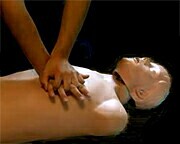
TUESDAY, Nov. 19, 2013 (HealthDay News) — CPR training rates are lower in poor, rural U.S. communities, according to a new study.
The finding is troubling because timely bystander CPR — cardiopulmonary resuscitation — can boost the odds of survival for those who experience cardiac arrest outside of the hospital.
The researchers also found that fewer people are trained in CPR in the South, Midwest and West. The study authors suggest this could help explain why bystander CPR is used less frequently in these areas.
Using data from the American Heart Association, the American Red Cross and the Health & Safety Institute, the investigators examined CPR training rates among roughly 13 million people living in more than 3,100 U.S. counties.
The study, published online on Nov. 18 in JAMA Internal Medicine, showed that counties with the lowest rates of CPR training — less than 1.3 percent of the population — were also more likely to have a greater proportion of rural areas, black and Hispanic residents, and a lower average household income.
These areas also had fewer doctors and, on average, older residents, according to a journal news release.
The researchers, led by Dr. Monique Anderson, of the Duke Clinical Research Institute, in Durham, N.C., noted that counties in the Northeast had higher rates of CPR training.
“With regard to rural areas, more studies are needed on interventions that target the entire chain of survival,” the study authors concluded.
More information
The American Heart Association has more about bystander CPR.
Copyright © 2025 HealthDay. All rights reserved.

